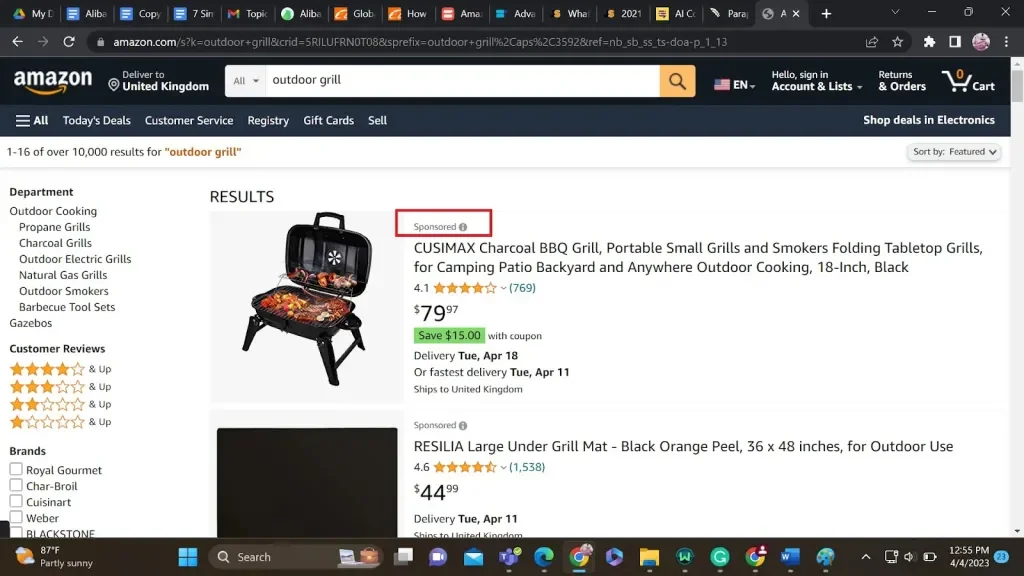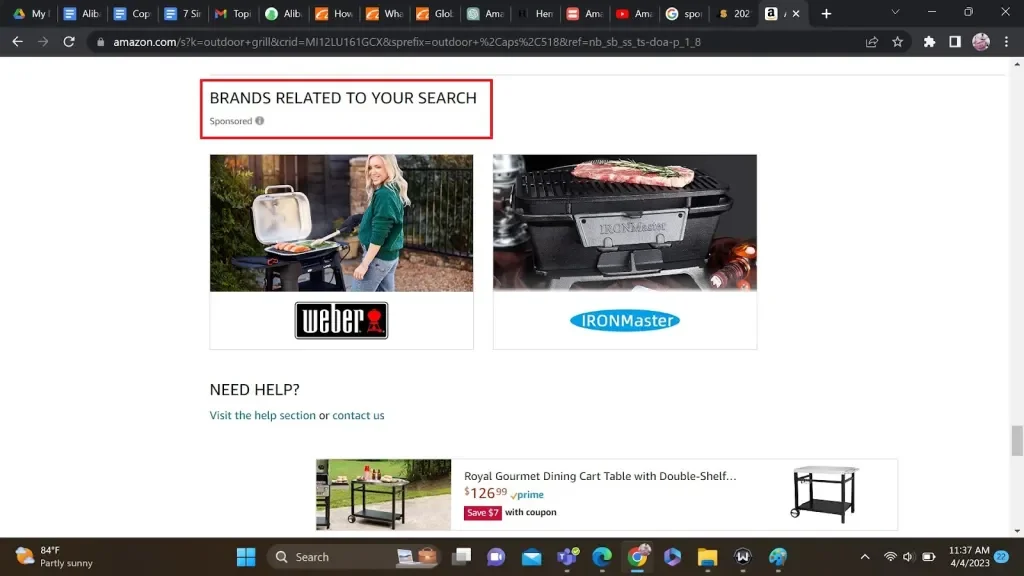Businesses are continuously searching for strategies to boost profits and increase market presence. Smart advertising will be one of the most reliable methods of increasing revenue, and Amazon Pay-Per-Click (PPC) is one such method.
Amazon’s yearly revenue was over US$ 31 billion on ads alone in 2021. By 2026, this amount is anticipated to reach US$ 64.3 billion. Leveraging the right strategies will give sellers a considerable advantage when optimizing their returns, particularly with Amazon.
In this blog post, we’ll discuss seven simple yet highly effective Amazon PPC strategies that will help you optimize your online profits. These strategies will help you become more visible, boost your organic sales, attract more clicks, and ultimately improve your sales on Amazon.
Table of Contents
Understanding Amazon PPC
Types of Amazon PPC ads
Top 7 strategies for using Amazon PPC to optimize profits
Conclusion
Understanding Amazon PPC
Amazon Pay-Per-Click is a platform for paid advertising with an auction-style structure. It enables independent Amazon sellers to purchase advertisements for specific keywords and display their products as sponsored adverts at the top of Amazon’s search results.
While your ad may appear as a result in several instances (hundreds, or even thousands, depending on the popularity of the product), you will only be charged for genuine clicks when you use Amazon PPC advertising.
This makes you stand out from the crowd while keeping your ad prices down. Also, it might help you get started with a fresh product launch if you don’t have any previous sales or reviews. This means that PPC optimization aids B2B marketers in increasing sales, generating high-quality leads, and outperforming rivals.
Amazon pay-per-click advertising can provide several advantages for your business, which include:
- Increased visibility: Amazon PPC affords businesses a wider reach. With over 300 million customers worldwide, Amazon PPC exposes you to numerous potential customers.
- Increased sales: By showing your ads to customers searching for similar products, you can drive more traffic to your listings and ultimately increase revenue.
- Cost-effective: Amazon PPC offers you a cheaper method of advertising. You don’t waste money on ineffective ads because you only get charged when someone clicks on them.
When done correctly, Amazon’s program offers various targeting options, allowing sellers to reach specific audiences and maximize their ROI. By understanding the ins and outs of Amazon PPC, sellers can take advantage of this powerful tool and achieve their business goals.
Amazon PPC key terms and features
Here are some key terms and features associated with Amazon PPC. These terms will help you understand Amazon PPC better.
CTR (Click-Through Rate) refers to the ratio of clicks to impressions. It gauges how frequently people who view your advertisement end up clicking it. Higher CTR means more clicks and potential sales.

Clicks are the number of times a person clicks on your advertisement. This is an important metric as it indicates how effectively your ad attracts clicks.
Impressions refer to the number of times your ad is shown to Amazon shoppers. This is important because it indicates how many potential customers have seen your ad.
ACoS (Advertising Cost of Sales) is the ratio of advertising spent to sales generated. This is a crucial metric as it helps determine if your ad spend generates a positive return on investment (ROI).

Bid is the amount you will pay for a click on your ad. This is important in determining where your ad will appear in the search results.
Types of Amazon PPC ads
Amazon provides three main PPC ad categories: Sponsored Products, Sponsored Brands, and Sponsored Displays.
- Sponsored Products: These ads appear in search results and product detail pages, featuring a product image, title, and price, and driving sales for specific products.

- Sponsored Brands: These ads appear at the top of search results and feature a custom headline, logo, and product images, driving sales for related products.

- Sponsored Display: These ads appear on Amazon and non-Amazon websites. They are an incredible way to raise awareness and boost sales for a variety of businesses. They feature product images, titles, and prices and are targeted to shoppers who have viewed or searched for similar products.

The critical takeaway for advertisers is that selecting the appropriate type of advertising is essential to maximizing the PPC campaign. Sponsored Products would be the ideal option to increase sales for a particular product. If you want to increase brand awareness, Sponsored Brands would be the best choice.
If you want to increase sales for a wide range of products, Sponsored Display would be the best choice. Knowing the strengths and weaknesses of each form of advertisement will help you make an informed choice.
Top 7 strategies for using Amazon PPC to optimize profits
Amazon PPC is a powerful advertising tool for sellers looking to increase their visibility and sales on the platform. Here are the top 7 strategies for using Amazon PPC to optimize profits:
Target the right audience
One of the critical activities in creating an effective Amazon PPC campaign is targeting the right audience. This means selecting the appropriate product category, setting up targeting options such as age, gender, location, and interests, and choosing the right keywords to target.
Example: A seller who sells premium yoga mats may target users who are interested in yoga, fitness, and wellness and are searching for keywords such as “yoga mats,” “premium yoga mats,” and “eco-friendly yoga mats.
Conduct keyword research
Keyword research is finding and analyzing search terms that people use to find products on Amazon. It is essential to conduct thorough keyword research to identify relevant, high-traffic keywords that can help increase the visibility of your product.
Example: Using a keyword research tool, a seller may find that keywords such as “yoga mat bag,” “yoga towel,” and “yoga blocks” are highly relevant to their product and have a high search volume.
Use negative keywords
Negative keywords are search terms for which you don’t want your ad to appear. You may add negative keywords to your campaign to show your ad to people who are likely to be interested in your product, thereby improving the relevancy and effectiveness of your campaign.
Example: A seller who sells premium yoga mats may want to exclude negative keywords such as “cheap yoga mats,” “free yoga mats,” and “yoga mats for beginners” from their campaign to avoid attracting low-value traffic.
Set strategic bids
Bids refer to the amount of money you are prepared to pay for each click on your ad. Setting the correct bid is essential because it determines what page your ad appears on, how often your ad is shown, and how much you pay for each click. Monitoring your bids regularly and adjusting them based on performance is essential. It is crucial to bid for the top spot on the first page.
Example: A seller may set a higher bid for highly relevant keywords with a high conversion rate, such as “premium yoga mats,” and a lower bid for less relevant keywords with a lower conversion rate, such as “yoga mat cleaner.”
Optimize your ad copy
Your ad copy is the text that appears in your ad and is crucial in convincing potential customers to click on your ad and make a purchase. Creating compelling, clear, and concise ad copy highlighting your product’s unique features and benefits is crucial.
Example: A seller may use ad copy that emphasizes the eco-friendliness and durability of their premium yoga mat, such as “Eco-Friendly Premium Yoga Mat – Non-Toxic, Sustainable, and Built to Last.”
Use automated campaigns
Automated campaigns use Amazon’s machine learning algorithms to target relevant keywords and audiences automatically. They can be a great way to save time and increase the efficiency of your campaign.
Example: A seller may use Amazon’s Automatic Targeting feature to let Amazon choose the keywords and targeting options for their campaign based on their product listing and performance data.
Use video ads
An excellent technique to advertise your goods is through video. Videos are powerful in engaging potential customers. They can be especially effective for visually appealing products or those that require demonstration.
Example: A seller who sells premium yoga mats may create a video ad that shows a yoga instructor using their mat in a beautiful outdoor setting, highlighting the mat’s quality and features.
Conclusion
Optimizing your Amazon PPC strategy is critical to boosting your profits. By implementing the above-mentioned strategies, from setting strategic bids to using video ads, you can increase your reach, drive more traffic, and generate more sales.
Amazon PPC can help you maximize ROI and make the most of every dollar you invest. Keep a watch on your advertising spending and how it relates to click-through rates and sales results, and make adjustments as necessary to ensure success.



